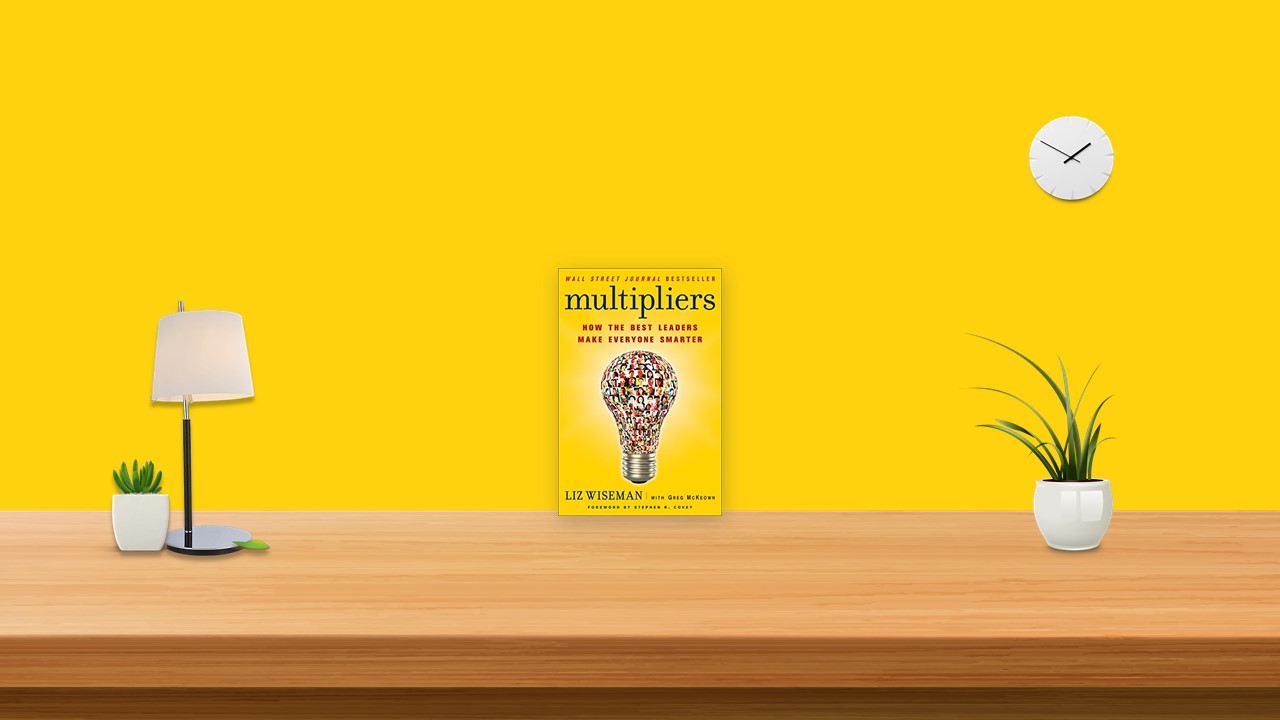Multipliers Versus Diminishers
MULTIPLIERS: These leaders are genius makers who bring out the intelligence in others. They build collective, viral intelligence in organizations.
DIMINISHERS: These leaders are absorbed in their own intelligence, stifle others, and deplete the organization of crucial intelligence and capability.
The Five Disciplines of the Multipliers
- The Talent Magnet: Attracts and optimizes talent
- The Liberator: Requires people’s best thinking
- The Challenger: Extends challenges
- The Debate Maker: Debates decisions
- The Investor: Instills accountability
The Accidental Diminisher
While true Diminishers are easier to spot, much of the diminishing that transpires in the workplace is a result of well-intended leaders whose honest attempts to lead or be helpful shut down ideas and cause others to hold back.
The Empire Builder Versus the Talent Magnet
EMPIRE BUILDERS bring in great talent, but they underutilize it because they hoard resources and use them only for their own gain.
TALENT MAGNETS get access to the best talent because people flock to work for them, knowing they will be fully utilized and developed to be ready for the next stage.
The Four Practices of the Talent Magnet
- Look for Talent Everywhere
- Appreciate all types of genius
- Ignore boundaries
- Find People’s Native Genius
- Look for what is native
- Label it
- Utilize People to Their Fullest
- Connect people with opportunities
- Shine a spotlight
- Remove the Blockers
- Get rid of prima donnas
- Get out of the way
Becoming a Talent Magnet
- Name the genius
- Supersize it
- Let go of a superstar
The Tyrant Versus the Liberator
TYRANTS create a tense environment that suppresses people’s thinking and capability. As a result, people hold back, bring up safe ideas that the leader agrees with, and work cautiously.
LIBERATORS create an intense environment that requires people’s best thinking and work. As a result, people offer their best and boldest thinking and give their best effort.
The Three Practices of the Liberator
- Create Space
- Release others by restraining yourself
- Shift the ratio of listening to talking
- Define a space for discovery
- Level the playing field
- Demand Best Work
- Defend the standard
- Distinguish best work from outcomes
- Generate Rapid Learning Cycles
- Admit and share mistakes
- Insist on learning from mistakes
Becoming a Liberator
- Play fewer chips
- Label your opinions
- Talk up your mistakes
- Make space for mistakes
The Know-It-All Versus the Challenger
KNOW-IT-ALLS give directives that showcase how much they know. As a result they limit what their organization can achieve to what they themselves know how to do. The organization uses its energy to deduce what the boss thinks.
CHALLENGERS define opportunities that challenge people to go beyond what they know how to do. As a result they get an organization that understands the challenge and has the focus and energy to take it on.
The Three Practices of the Challenger
- Seed the Opportunity
- Show the need
- Challenge the assumptions
- Reframe problems
- Create a starting point
- Lay Down a Challenge
- Extend a concrete challenge
- Ask the hard questions
- Let others fill in the blanks
- Generate Belief in What is Possible
- Helicopter down
- Cocreate the plan
- Orchestrate an early win
Becoming a Challenger
- Take the extreme questions challenge
- Create a stretch challenge
- Take a bus trip
- Take a massive baby step
The Decision Maker Versus the Debate Maker
DECISION MAKERS decide efficiently with a small inner circle, but they leave the broader organization in the dark to debate the soundness of the decision instead of executing it.
DEBATE MAKERS engage people in debating the issues up front, which leads to sound decisions that people understand and can execute efficiently.
The Three Practices of the Debate Maker
- Frame the Issue
- Define the question
- Form the team
- Assemble the data
- Frame the decision
- Spark the Debate
- Create safety for best thinking
- Demand rigor
- Drive a Sound Decision
- Reclarify the decision-making process
- Make the decision
- Communicate the decision and rationale
Becoming a Debate Maker
Make a debate with four asks
1) Ask the hard question
2) ask for evidence
3) ask everyone
4) ask people to switch
The Micromanager Versus the Investor
MICROMANAGERS manage every detail in a way that creates dependence on the leader and their presence for the organization to perform.
INVESTORS give other people the investment and ownership they need to produce results independent of the leader.
The Three Practices of the Investor
- Define Ownership
- Name the lead
- Give ownership for the end goal
- Stretch the role
- Invest Resources
- Teach and coach
- Provide backup
- Hold People Accountable
- Give it back
- Expect complete work
- Respect natural consequences
Becoming an Investor
- Give 51 percent of the vote
- Let nature take its course
- Ask for the F-I-X
- Give it back
The Accidental Diminisher
ACCIDENTAL DIMINISHERS are managers who, despite the very best of intentions, have a diminishing impact on the people they lead.
Accidental Diminisher Profiles
Idea Guy: Creative, innovative thinkers who think they are stimulating ideas in others
Always On: Dynamic, charismatic leaders who think their energy is infectious
Rescuer: Empathetic leaders who are quick to help when they see people struggling
Pacesetter: Achievement-oriented leaders who lead by example and expect others to notice and follow
Rapid Responder: Leaders who are quick to take action believing that they are building an agile, action-oriented team
Optimist: Positive, can-do leaders who think their belief in people will inspire them to new heights
Protector: Vigilant leaders who shield people from problems to keep them safe
Strategist: Big thinkers who cast a compelling vision thinking they are showing people a better place and providing the big picture
Perfectionist: Leaders who strive for excellence and manage the fine details to help others produce superior work
Decreasing your Accidental Diminisher Tendencies
- Seek feedback
- Lead with intention
- Do less and challenge more
Dealing with Diminishers
You can be a Multiplier while working for a Diminisher.
Breaking the Cycle of Diminishing
- It’s not necessarily about you
- Diminishing isn’t inevitable
- You can lead your leader
Level 1: Defenses Against the Dark Arts of Diminishing Managers
Basic survival strategies intended to improve your reactions to Diminishers, relieve stress, neutralize immediate problems, and halt the downward spiral.
- Turn down the volume
- Strengthen other connections
- Retreat and regroup
- Send the right signals
- Assert your capability
- Ask for performance intel
- Shop for a new boss
Level 2: Multiplying Up
Offense plays to help you be a Multiplier to those above you in the organization or to diminishing colleagues at your side, especially Accidental Diminishers.
- Exploit your boss’s strengths
- Give them a user’s guide
- Listen to learn
- Admit your mistakes
- Sign up for a stretch
- Invite them to the party
Level 3: Inspiring Multiplier Leadership in Others
Strategies that raise awareness and encourage leaders to make the shift from Accidental Diminisher to a more intentional Multiplier.
- Assume positive intent
- Address one issue at a time
- Celebrate progress
Becoming a Multiplier
Starting the Journey
- Resonance
- Realization of the Accidental Diminisher
- Resolve to be a Multiplier
The Accelerators
- Start with the assumptions
- Work the extremes (neutralize a weakness; top off a strength)
- Run an experiment
- Ask a colleague
- Brace yourself for setbacks
Elements of a Culture
- Common language: Words and phrases that hold a common meaning within a community based on opinions, principles, and values
- Learned behaviors: A set of learned responses to stimuli
- Shared beliefs: The acceptance of something as true
- Heroes and legends: People who are admired or idealized for their qualities, behavior, and/or achievements and the stories told about heroic actions
- Rituals and norms: Consistent behavior regularly followed by an individual or a group


